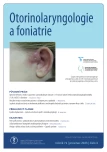Language adaptation of a swallowing assessment tool in non-surgically treated head and neck tumour patients
Authors:
Žofia Frajková 1-3
; Miroslav Tedla 1,4
Authors‘ workplace:
Klinika otorinolaryngológie a chirurgie hlavy a krku LF UK a UN Bratislava
1; Katedra logopédie, Pedagogická fakulta UK v Bratislave
2; Neurologické oddelenie, FN Trnava
3; Institute of Cancer and GenomicSciences, University of Birmingham, Veľká Británia
4
Published in:
Otorinolaryngol Foniatr, 72, 2023, No. 4, pp. 197-203.
Category:
Original Article
doi:
https://doi.org/10.48095/ccorl2023197
Overview
Objective: The objective of the study is the language adaptation of the diagnostic tool Dynamic Imaging Grade of Swallowing Toxicity (DIGEST), which aims at the uniform assessment of flexible endoscopic swallowing examination (FEES) in non-surgically treated patients with head and neck tumours. Material and methods: The language adaptation of the original English version of DIGEST-FEES was carried out based on the recommendations of the World Health Organization. The language adaptation consisted of the translation of the tool into the target language, an expert panel evaluating the cultural and linguistic correctness of the translation and back-translation into the original language. Results: Based on a valid translation, a Slovak version of DIGEST-FEES sk was created, which is culturally, linguistically and structurally adapted to Slovak conditions. Conclusion: New diagnostic tool DIGEST-FEES en version 1.1. enables uniform reporting of swallowing deficits in non-surgically treated head and neck tumour patients, and quantified follow-up of swallowing changes over time.
Keywords:
dysphagia – diagnostic procedures – head and neck tumours
Sources
1. Baijens LWJ, Walshe M, Aaltonen LM et al. European white paper: oropharyngeal dysphagia in head and neck cancer. Eur Arch Otorhinolaryngol 2021; 278 (2): 577–616. Doi: 10.1007/s00405-020-06507-5.
2. European Society for Swallowing Disorders. ESSD Position Statements: Oropharyngeal Dysphagia in Adult Patients. [on-line] 2008. Dostupné z: http: //www.myessd.org/docs/position_statements/ESSD_Position_Statements_on_OD_in_adult_patients_for_web.pdf
3. Denaro N, Merlano MC, Russi EG. Dysphagia in Head and Neck Cancer Patients: Pretreatment Evaluation, Predictive Factors, and Assessment during Radio-Chemotherapy, Recommendations. Clin Exp Otorhinolaryngol 2013; 6 (3): 117–126. Doi: 10.3342/ceo.2013.6.3.117.
4. Denk DM, Bigenzahn W. Management oropharyngealer Dysphagien. HNO (Heilkunde, Phoniatrie und Logopädie) 2005; 53 : 661–672. Doi: 10.1007/s00106-005-1284-4.
5. Starmer H, Gourin C, Lua LL et al. Pretreatment swallowing assessment in head and neck cancer patients. Laryngoscope 2011; 121 (6): 1208–1211. Doi: 10.1002/lary.21800.
6. Bouřová A, Podlešák T. Přehled nejčastějších lokálních komplikací onkologické léčby nádorů hlavy a krku. Otorinolaryngol Foniatr 2010; 69 (1): 24–30.
7. Malá E, Vejražková E, Vošmik M et al. Kva lita života nemocných s rakovinou hlavy a krku ve tříletém sledování nutriční ambulancí. Otorinolaryngol Foniatr 2016; 65 (1): 9–16.
8. Klozar J. Role chemoterapie v léčbě karcinomů hlavy a krku. Otorinolaryngol Foniatr 2008; 57 (1): 159–164.
9. Neubauer PD, Rademaker AW, Leder SB. The Yale Pharyngeal Residue Severity Rating Scale: An Anatomically Defined and Image-Based Tool. Dysphagia 2015; 30 (5): 521–528. Doi: 10.1007/s00455-015-9631-4.
10. Rosenbek JC, Robbins JA, Roecker EB et al. A penetration-aspiration scale. Dysphagia 1996; 11 (2): 93–98. Doi: 10.1007/BF00417897.
11. Steele CM, Grace-Martin K. Reflections on Clinical and Statistical Use of the Penetration-Aspiration Scale. Dysphagia 2017; 32 (5): 601–616. Doi: 10.1007/s00455-017-9809-z.
12. Banda KJ, Chu H, Kao CC et al. Swallowing exercises for head and neck cancer patients: A systematic review and meta-analysis of ran domized control trials. Int J Nurs Stud 2021; 114 : 103827. Doi: 10.1016/j.ijnurstu.2020.103827.
13. Benfield JK, Everton LF, Bath PM, et al. Does Therapy With Biofeedback Improve Swallowing in Adults With Dysphagia? A Systematic Review and Meta-Analysis. Arch Phys Med Rehab 2019; 100 (3): 551–561. Doi: 10.1016/j.apmr.2018.04.031.
14. Greco E, Simic T, Ringash J et al. Dysphagia Treatment for Patients With Head and Neck Cancer Undergoing Radiation Therapy: A Meta-analysis Review. I Int J Radiat Oncol Biol Phys 2018; 101 (2): 421–444. Doi: 10.1016/j.ijrobp.2018.01.097.
15. World Health Organization. Process of translation and adaptation of instruments. [on-line] 2008. Dostupné z URL: https: //www.google.com/url?sa=t&rct=j&q=&esrc=s&source=web&cd=&ved=2ahUKEwjFyebJqsT8AhWOsKQKHRZTAWYQFnoECA4QAw&url=https%3A%2F%2Fwww.mhinnovation.net%2Fsites%2Fdefault%2Ffiles%2Ffiles%2FWHO%2520Guidelines%2520on%2520Translation%2520and%2520Adaptation%2520of%2520Instruments.docx&usg=AOvVaw3nckW01UVecjsB0KihFkLC.
16. Langmore SE. Endoscopic evaluation of oral and pharyngeal phases of swallowing. GI Motility Online 2006. Doi: 10.1038/gimo28.
17. Starmer HM, Arrese L, Langmore S et al. Adaptation and Validation of the Dynamic Imaging Grade of Swallowing Toxicity for Flexible Endoscopic Evaluation of Swallowing: DIGEST-FEES. J Speech Lang Hear Res 2021; 64 (6): 1802–1810. Doi: 10.1044/2021_JSLHR-21-00014.
18. Hutcheson KA, Barrow MP, Barringer DA et al. Dynamic Imaging Grade of Swallowing Toxicity (DIGEST): Scale Development and Validation. Cancer 2017; 123 (1): 62–70. Doi: 10.1002/cncr.30283.
19. Starmer H. DIGEST-FEES [on-line]. 2022. Dostupne z URL: https: //med.stanford.edu/ohns/ education/continuing-education/symposia/swallowing-disorders-awareness-symposium.html.
Labels
Audiology Paediatric ENT ENT (Otorhinolaryngology)Article was published in
Otorhinolaryngology and Phoniatrics

2023 Issue 4
Most read in this issue
- Vertigo with sudden hearing loss and eye symptoms – Cogan‘s syndrome
- Current trends in the management of patients with cleft lip and cleft palate
- Surgical treatment and recurrence of preauricular sinus over a 15-year period at the Clinic of Children Otorhinolaryngology of the MFCU and the NICD in Bratislava
- Hyaluronic acid and its importance and possibilities of use in otorhinolaryngology
